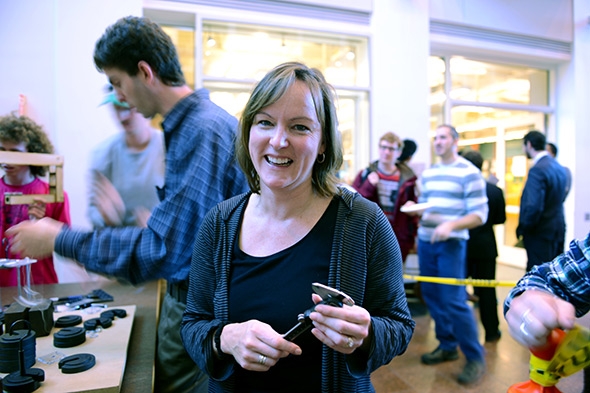Read the full story by Alex Arcone, published by Thayer School of Engineering.
The Council for Advancement and Support of Education (CASE) and the Carnegie Foundation for the Advancement of Teaching have jointly named Dartmouth Associate Professor of Engineering Vicki May the 2013 New Hampshire Professor of the Year. CASE and the Carnegie Foundation give the award annually to undergraduate teachers “who excel in teaching and positively influence the lives and careers of students.”

Associate Professor of Engineering Vicki May says that, “being able to tie everything together by actually building something gets students excited and helps them learn.” (Photo by Karen Endicott/Thayer School of Engineering)
May’s hands-on approach to teaching, combined with a relaxed demeanor, draws many students to her classes, which include “Integrated Design,” “Solid Mechanics,” “Intermediate Solid Mechanics,” and “Structural Analysis.”
“I don’t like to listen to me talk for 50 minutes, so I’m sure they don’t like it either,” May says. Instead, she likes to get students working on real projects. “There’s lots of theory, and that’s important, but being able to tie everything together by actually building something gets students excited and helps them learn, because they see a real context to all the math and science they’ve been doing.”
“Professor May is one of those rare professors who most of all want students to learn as much as possible and to enjoy the process,” says Noam Rosenthal ’13. “What really helped me was Vicki’s lecture method. She goes through complete examples in class and allows time for students to try examples on their own. By the time I started the problem set, I was very comfortable with the material.”
“Vicki’s teaching is one of the best examples of tying the fundamentals to real-world application,” says Joseph Helble, Thayer dean and professor of engineering. “In her courses, students learn the underlying theory and then spend a large part of their time applying this knowledge to an open-ended design problem that challenges them intellectually and creatively. Her classes are in high demand, and the engaged learning that takes place in her classroom is the reason why.”